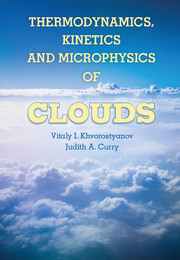Description
Thermodynamics, Kinetics, and Microphysics of Clouds
Authors: Khvorostyanov Vitaly I., Curry Judith A.
This book advances understanding of cloud microphysics and provides a unified theoretical foundation for modeling cloud processes, for researchers and advanced students.
Language: English
Subject for Thermodynamics, Kinetics, and Microphysics of Clouds:
Approximative price 112.80 €
In Print (Delivery period: 14 days).
Add to cart
Publication date: 08-2014
800 p. · 18.2x26 cm · Hardback
800 p. · 18.2x26 cm · Hardback
Description
/li>Contents
/li>Biography
/li>
Thermodynamics, Kinetics, and Microphysics of Clouds presents a unified theoretical foundation that provides the basis for incorporating cloud microphysical processes in cloud and climate models. In particular, the book provides: ? A theoretical basis for understanding the processes of cloud particle formation, evolution and precipitation, with emphasis on spectral cloud microphysics based on numerical and analytical solutions of the kinetic equations for the drop and crystal size spectra along with the supersaturation equation ? The latest detailed theories and parameterizations of drop and crystal nucleation suitable for cloud and climate models derived from the general principles of thermodynamics and kinetics ? A platform for advanced parameterization of clouds in weather prediction and climate models ? The scientific foundation for weather and climate modification by cloud seeding. This book will be invaluable for researchers and advanced students engaged in cloud and aerosol physics, and air pollution and climate research.
1. Introduction; 2. Clouds and their properties; 3. Thermodynamic relations; 4. Properties of water and aqueous solutions; 5. Diffusion and coagulation growth of drops and crystals; 6. Wet aerosol process; 7. Activation of cloud condensation nuclei into cloud drops; 8. Homogeneous nucleation; 9. Heterogeneous nucleation of drops and ice crystals; 10. Parameterizations of heterogeneous ice nucleation; 11. Deliquescence and efflorescence in atmospheric aerosols; 12. Terminal velocities of drops and crystals; 13. Broad size spectra in clouds and theory of stochastic condensation; 14. Analytical solutions to the stochastic kinetic equation.
Vitaly Khvorostyanov is Professor of Physics of the Atmosphere and Hydrosphere, Central Aerological Observatory (CAO), Russian Federation. His research interests are in cloud physics, cloud numerical modeling, atmospheric radiation, cloud-aerosol and cloud-radiation interactions with applications for climate studies and weather modification. He has served as Head of the Laboratory of Numerical Modeling of Cloud Seeding at CAO, Coordinator of the Cloud Modeling Programs on Weather Modification by Cloud Seeding in the USSR and Russia, Member of the International GEWEX Radiation Panel of the World Climate Research Program and Member of the International Working Group on Cloud-Aerosol Interactions. Dr Khvorostyanov has worked as a visiting scientist and Research Professor in the United States, United Kingdom, France, Germany and Israel. He has co-authored nearly 200 journal articles and four books: Numerical Simulation of Clouds (1984), Clouds and Climate (1986), Energy-Active Zones: Conceptual Foundations (1989) and Cirrus (2002). Dr Khvorostyanov is a member of the American Geophysical Union and the American Meteorological Society.
Judith Curry is Professor and Chair of the School of Earth and Atmospheric Sciences at the Georgia Institute of Technology. She previously held faculty positions at the University of Colorado, Penn State University and Purdue University. Dr Curry's research interests span a variety of topics in the atmospheric sciences and climate. Current interests include cloud microphysics, air and sea interactions and climate feedback processes associated with clouds and sea ice. Dr Curry is co-author of Thermodynamics of Atmospheres and Oceans (1999) and editor of the Encyclopedia of Atmospheric Sciences (2003). She has published more than 190 refereed journal articles. Dr Curry is a Fellow of the American Meteorological Society, the American Association for the Advancement of Science and the American Geophysical Union. In 1992, she received the He
Judith Curry is Professor and Chair of the School of Earth and Atmospheric Sciences at the Georgia Institute of Technology. She previously held faculty positions at the University of Colorado, Penn State University and Purdue University. Dr Curry's research interests span a variety of topics in the atmospheric sciences and climate. Current interests include cloud microphysics, air and sea interactions and climate feedback processes associated with clouds and sea ice. Dr Curry is co-author of Thermodynamics of Atmospheres and Oceans (1999) and editor of the Encyclopedia of Atmospheric Sciences (2003). She has published more than 190 refereed journal articles. Dr Curry is a Fellow of the American Meteorological Society, the American Association for the Advancement of Science and the American Geophysical Union. In 1992, she received the He
© 2024 LAVOISIER S.A.S.

